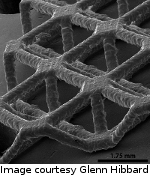Research Projects
Each year two to four positions for master's and doctoral students arise in these projects. Please contact Prof Steeves if you have a particular interest in one or more projects. The graduate student application procedure for UTIAS can be found here. Note that all prospective Canadian students should apply for the NSERC Canada Graduate Scholarship - Master's Program and the Ontario Graduate Scholarship. The deadline for CGS-M is in December, so please be prepared to apply early. International students should apply for any scholarship support for which they are eligible.
 |
Topology optimization | Modern advanced manufacturing techniques enable the fabrication of structures that are much more complex geometrically than was possible even twenty years ago. Our capacity to model and design complex structures is relatively limited, but topology optimization is a very promising approach. Our group explores topology optimization algorithms for a variety of material systems, including nanometal-coated polymers and 3D-printed polymers. In particular, we are interested in the application of topology optimized structures in the drone industry, where highly efficient structures are of paramount importance. |
 |
Hybrid polymer-nanometal structures | Additive manufacturing is a convenient method for generating complex shapes. Enhancing 3D printed polymer with coatings of electrodeposited nanocrystalline metal enables lightweight structures with complex geometry and excellent mechanical characteristics. Our research in this area revolves around mechanical modelling of the resulting hybrid structures, particularly the failure mechanisms associates with coated materials. This project is in collaboration with Prof Glenn Hibbard of Materials Science and Engineering. |
 |
Tailored composites | Composite materials are exceptionally attractive for aerospace applications because of their high strength and stiffness to mass. In addition, by designing the fibre layout properly, it is possible to change some of the other properties of the composite structure. For instance, by choosing the correct fibre layout, vibrational band gaps can be designed into the structure. Our work concentrates on creating new high-fidelity models of complex composites and employing these models efficiently in optimization schemes. |
 |
Low thermal expansion lattices | By choosing the appropriate geometry for a bimaterial lattice, it is possible to attain both low, tailorable thermal expansion and nearly optimal stiffness. By appropriate selection of materials and geometry, lattices with anisotropic thermal expansion can be fabricated for use as adapters and thermal actuators. Examples of these lattices in several materials, including composites and refractory metals, are being designed, built and tested. Currently, they are being examined for use in space telescopes and large array mirrors. |
30 October 2018 - C A Steeves